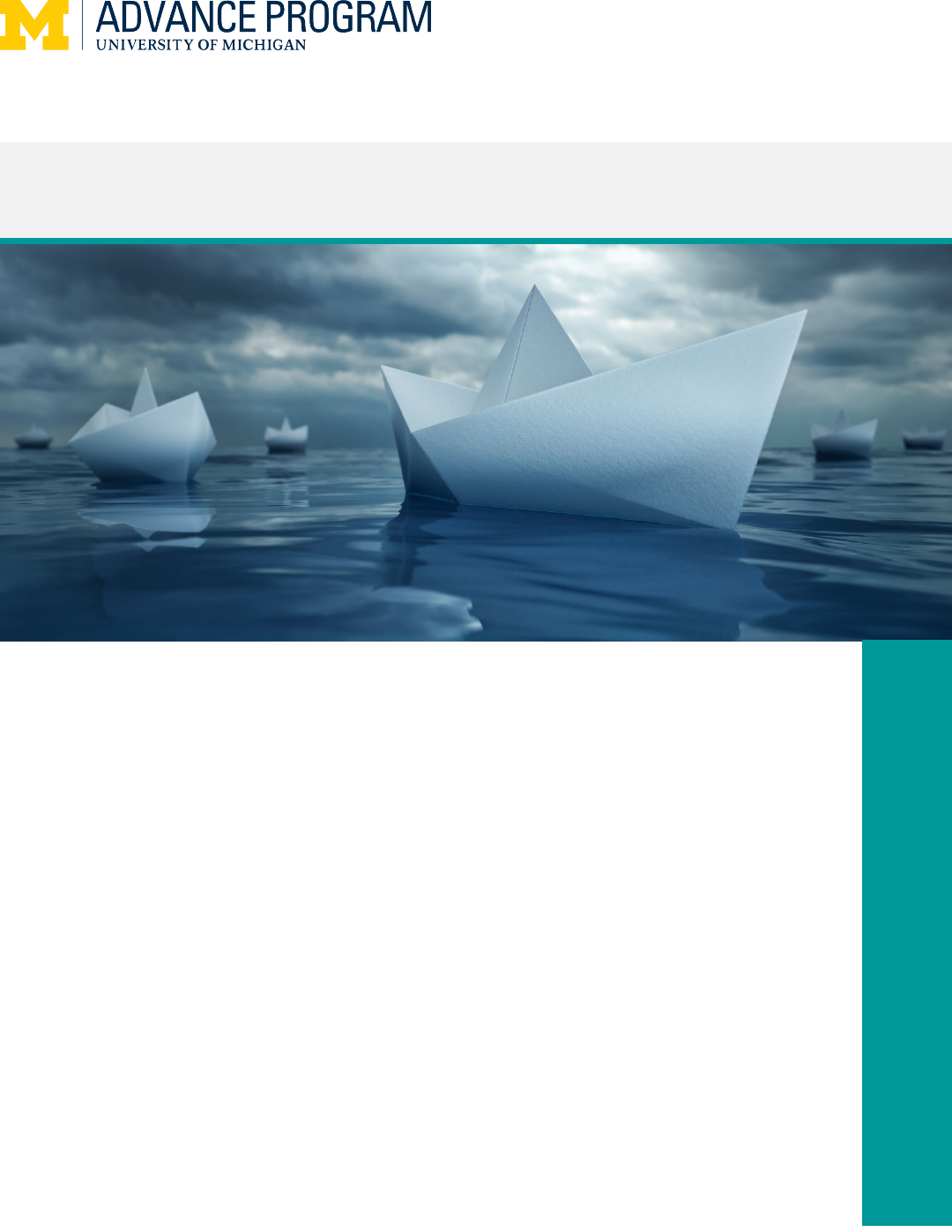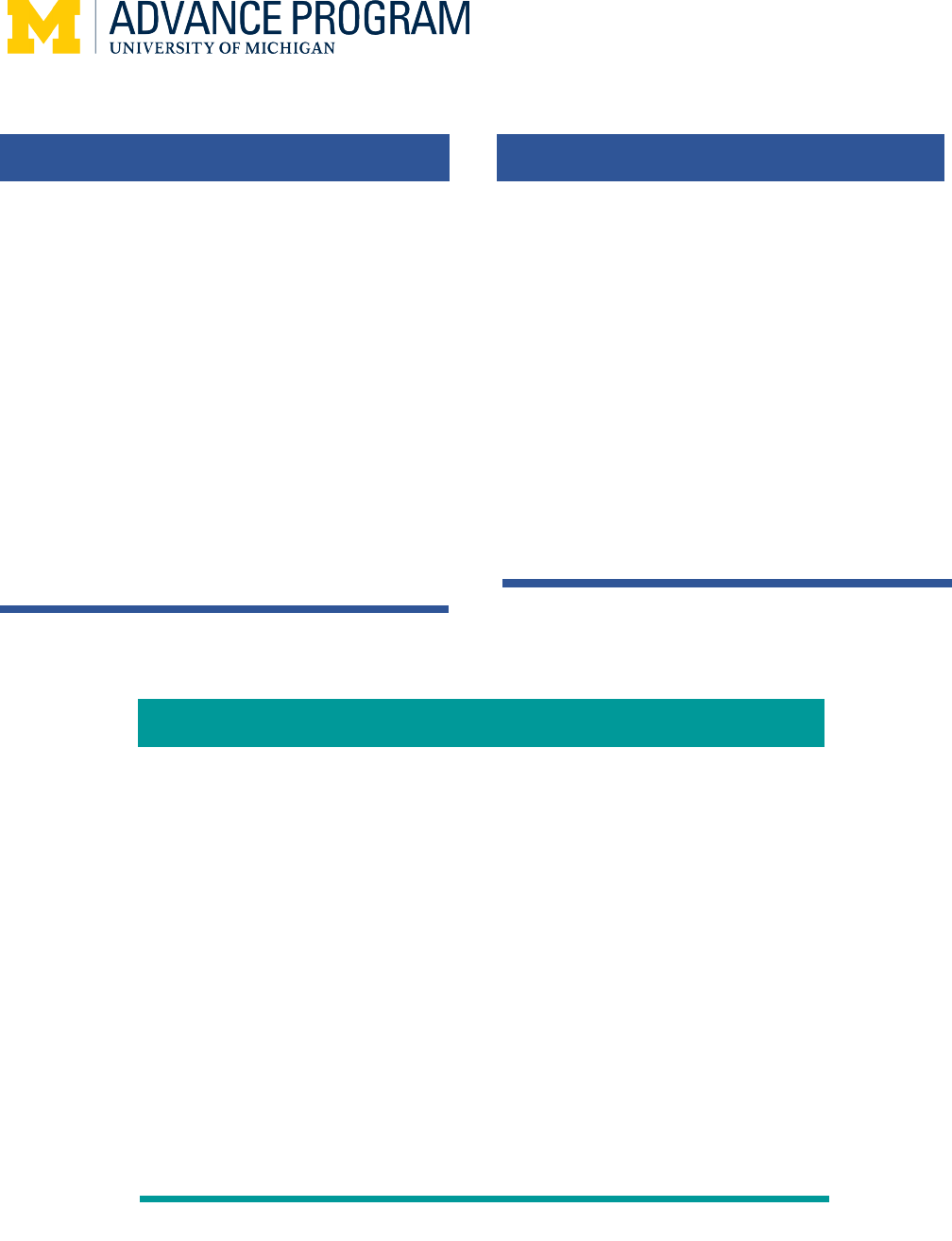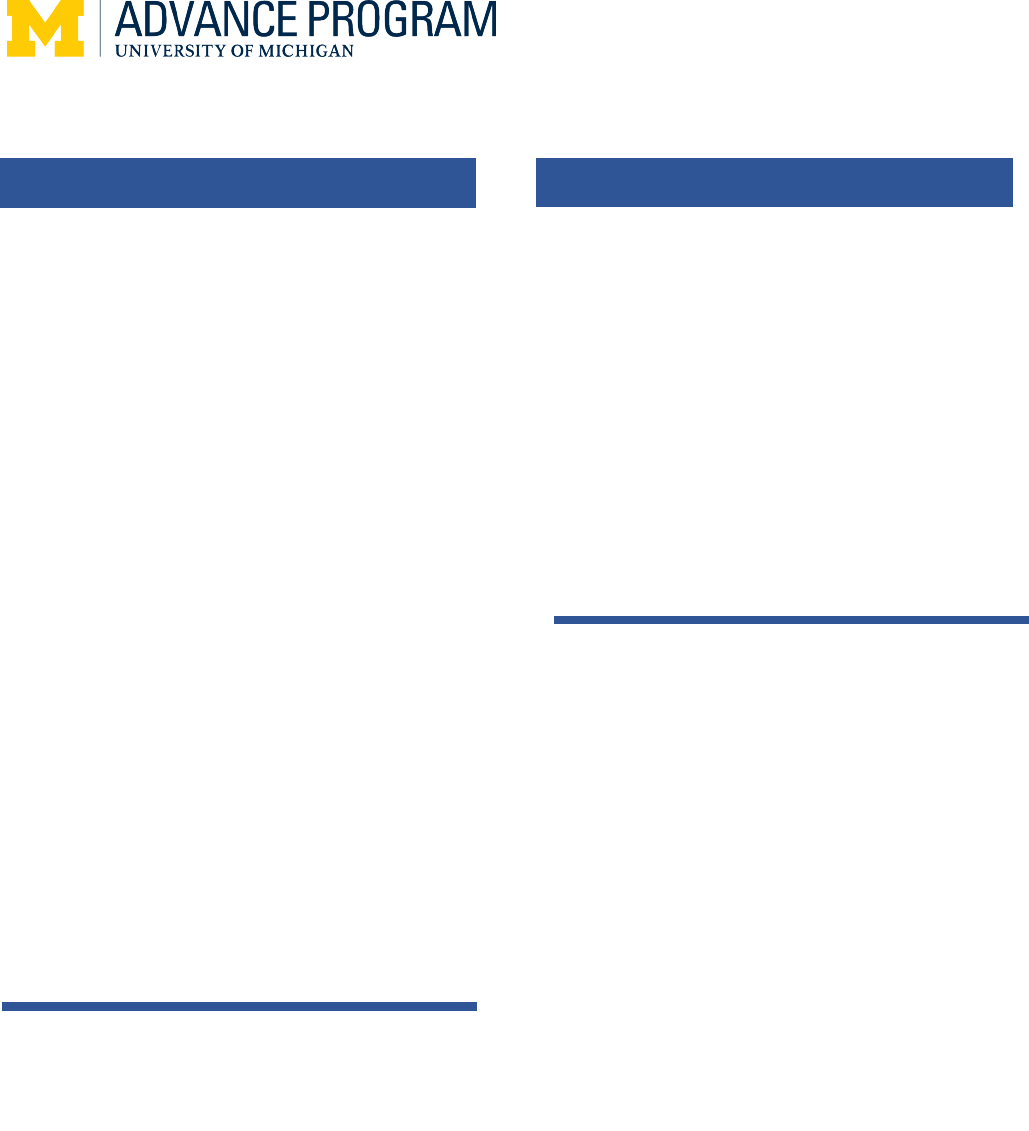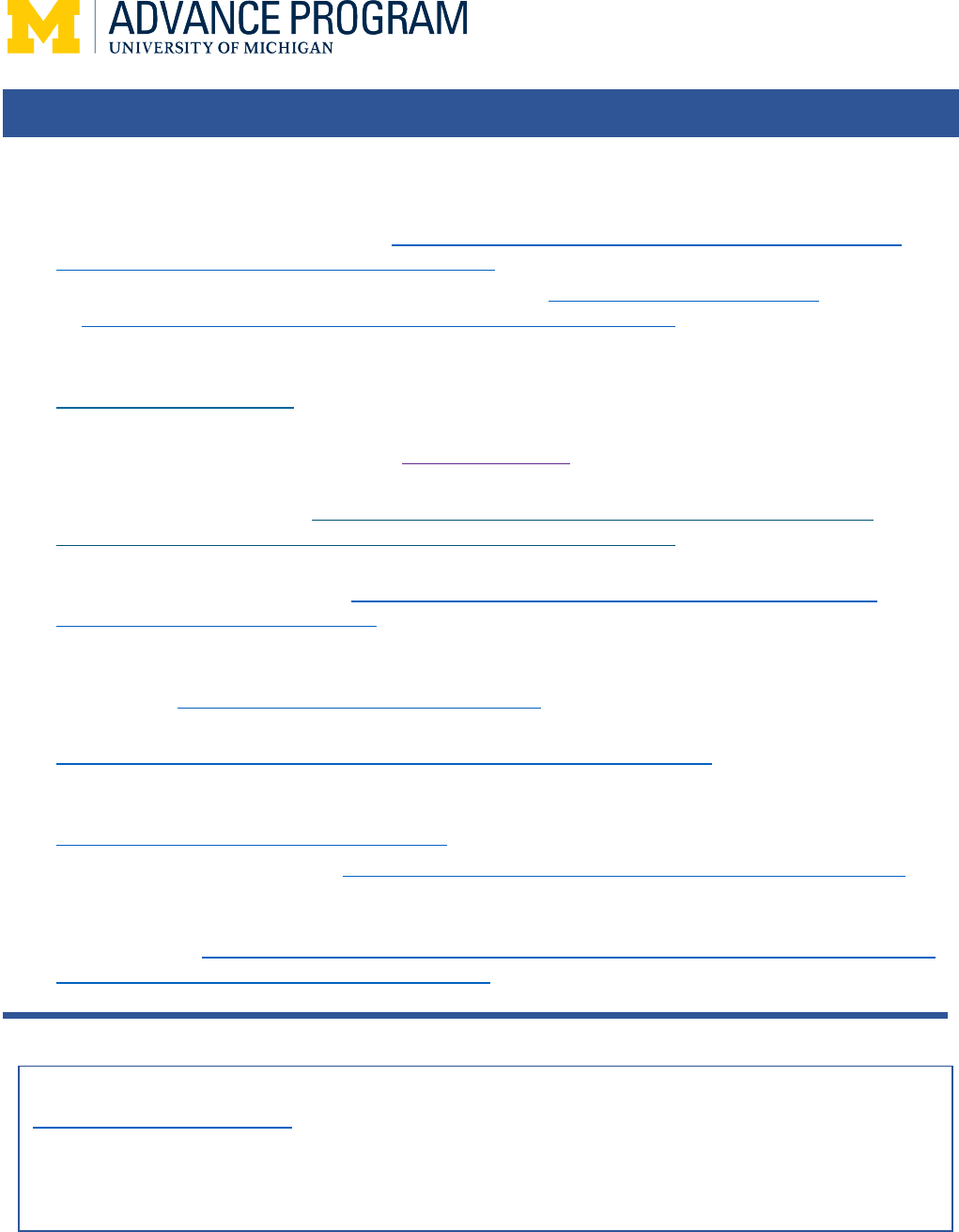
1
Faculty Equity & COVID-19
The problem, the evidence, and recommendations
Scholars have been documenting the unique challenges faced by
faculty of color, women, and other marginalized groups in terms of
their hiring, retention, and advancement.
1
Many individuals in
these groups were already walking a tightrope to be successful
while managing family responsibilities, negotiating cultural
differences, and having limited access to the privileges typically
conferred to faculty members (e.g., status, security, presumed
competence). The pandemic has exacerbated inequalities by
removing the supports that had allowed marginalized faculty to
stay atop the tightrope. Yet awareness of the precarity of
marginalized faculty offers U-M the opportunity to reset in a way
that better supports all faculty.
W
E ARE ALL IN THE SAME STORM
,
BUT NOT IN THE SAME BOAT
.

2
There is increasing evidence that the COVID-19 pandemic is having a differential impact on
the productivity of faculty from different groups.
Many faculty report that they are busier now than
before the pandemic, and women are more likely
than men to say they are busier now than before
(57% vs. 43%).
2
Across faculty groups, there has been a change in the
distribution of work efforts, with less time devoted
to research and more time spent on teaching and
service.
2,3
However, this change in distribution of
efforts is not equal across groups.
• The decrease in available time for research and
writing is greater for women than men,
2
and
greatest for women with young dependents.
3
Data suggest that women are submitting fewer
papers and pre-prints, are less likely to hold
primary author position, and are less likely to
submit single author papers.
4,5,6
Disparities may
increase in the next few years as the
consequences of COVID-19 accumulate and
affect scholarly endeavors.
• Women have less time for research and writing
because of their greater caregiving
responsibilities,
2
and when they have time for
research and writing, they are more likely to be
interrupted by dependents.
7
• A study of non-academics indicated that men
with children reported being more productive
since the pandemic, and were more likely to have
received a promotion, raise, recognition, or more
leadership responsibility.
8
• Among non-academics, White workers reported
being more productive since the pandemic
started, and were more likely to have taken on
additional leadership than Black and Asian
workers.
8
Other work responsibilities may account for
declines in time for research for faculty of color
and women.
• Many scholars report that teaching online
limits their time for research, with women
more likely to say this than men.
2
• Racial injustice (e.g., racial disparities in
COVID-19 outcomes, anti-Asian prejudice,
anti-Black violence) is creating disruptive
distress for faculty of color.
9
• Faculty of color and women are doing more
emotional labor through supporting students
and performing service.
10
Barriers to research also differed for faculty in
different disciplines.
• Among faculty in STEM, those in the bench
sciences had the largest decrease in time for
research due to lack of access to their labs.
3
• Scholars in the humanities reported
significant barriers to accessing materials for
their research; this was also reported by
social science scholars to a lesser degree.
2
The publication process may be slowing for
many scholars. Journal editors have noted an
increase in declined reviewer invitations and an
increase in requests for review extensions.
6
A minority of faculty (24%) report having more
time for research and writing.
2
• Men (27%) and faculty in STEM (27%) were more
likely to say they have more time to write than
women (18%) and faculty in humanities (22%)
and social science (18%).
• More time for research and writing was
attributed to fewer meetings, lack of
commute, not teaching, and fewer
distractions at home.
T
HE GLOBAL EVIDENCE OF PANDEMIC INEQUALITY ON FACULTY

3
COVID-19
IMPACT ON
U-M
FACULTY
In August, 2020, an informal survey about experiences related to the COVID-19 pandemic was
sent to members of four faculty networks administered by the U-M ADVANCE Program: the
Network to Advance Women Scientists and Engineers, the Network to Advance Faculty of Color,
the UM-LGBT Faculty Alliance, and the Single Faculty Network.* The results mirror the global
data in many ways (see “The Effect of COVID-19 on UM Faculty Life: Results from a Limited Survey
conducted by the ADVANCE Program” for more detail as well as strategies faculty employed to
manage challenges).
• 77% of respondents reported lower work productivity. Challenges included being unable to
access materials or space needed for scholarship, difficulty collaborating with colleagues,
and inadequate home workspace and infrastructure.
• 37% reported increased workload due to online teaching.
• 33% reported challenges due to caregiving; parents found it especially difficult to manage
work while assisting their children who were accessing school remotely through online
instruction. As a reference point, the ADVANCE Program’s 2017 campus-wide climate survey
indicated that 48% of tenure-track faculty have children they care for, and 13% are caring
for another adult.
• 24% reported challenges in mentoring students online.
• 24% reported negative psychological effects of the pandemic.
• 15% reported an increase in demands on their time related to new COVID-related service,
other administrative work, and the volume of emails.
There are clear warning signs here – about faculty not being able to address their own well-being,
reduced productivity despite an increased workload, and childcare needs (that added to critical
previous childcare needs).
* Note: Demographic information was not collected to preserve anonymity.
Image credit: https://finshots.in/archive/walking-the-tightrope/

4
To address the disparities that have been exacerbated by the COVID-19 pandemic, we offer
suggestions in several areas. These recommendations are based on suggestions offered by other
scholars (see suggested reading section), empirical research, and the faculty we surveyed. Be aware
that because the effect of the pandemic has been felt unequally by faculty in different groups,
identity-neutral responses may inadvertently exacerbate inequality. Maintaining a commitment
to diversity (i.e., greater representation), equity (i.e., adequate resources and policies to provide
equal opportunities), and inclusion (i.e., an environment permitting full acceptance, belonging, and
participation) is critical to avoid significant loss of faculty from marginalized groups.
R
ECOMMENDATIONS FOR SUPPORTING FACULTY
• Acknowledge to faculty that a “COVID slow-
down” is expected and acceptable.
• Provide supports for conducting and
managing research: e.g., editorial assistance
for papers and proposals; project
management software to keep remote
teams connected and manage workflow;
funds to support faculty on existing research
or as they pivot to new methods and topics.
• Increase flexibility: e.g., allow new faculty to
spend start-up funds, provide start-up
timeline extensions, reschedule sabbaticals.
• Make sure spending restrictions consider
equity (e.g., (un)availability of other
resources).
• Provide opt-out tenure clock extensions for
tenure track faculty but be aware that
these do not help research track faculty.
With awareness that tenure clock
extensions may exacerbate inequality (by
increasing the lifetime earnings of those
tenured in fewer years), consider making
promotion salary increases retroactive to
when the faculty member would have
usually gone up for tenure (as UMass-
Amherst administration has committed to
doing).
11
SERVICE
RESEARCH
• During the pandemic, reduce service and
meetings to only essential activities.
• Postpone some activities (e.g., internal
reviews, events) and consider streamlining
others (e.g., annual review) to reduce
demands on time and resources. Post-
pandemic, evaluate whether some
committees could be disbanded; consider
that some meetings may remain online
(e.g., faculty meetings).
• Temporarily reduce or waive formal
service for faculty with significant
caregiving demands; this can also make
space for informal service that women and
faculty of color may be engaged in. Pair
this with reducing formal service generally
so as not to shift the burden onto faculty
without these demands.
• Create mechanisms for making invisible
service work (e.g., supporting students
during the pandemic) more visible.
Recognize that women and faculty of color
are more likely to engage in this work
generally, and especially during the
pandemic.

5
TEACHING
• During the pandemic, allow instructors to
teach in their desired mode (in person,
hybrid, online) without needing to justify
their preference. Post-pandemic, consider
whether some courses might have online
components as teaching online may create
more opportunities for some faculty (e.g.,
caregivers, faculty with disabilities).
• Create more formalized mechanisms to
cover courses for faculty who need to be
absent for more than one or two classes
due to unexpected issues (e.g., illness,
family emergencies) or chronic health
problems.
• For untenured faculty with significant
caregiving demands who are teaching
during the pandemic, provide them with a
course release in a future semester prior
to tenure review. These releases can be
staggered to reduce pressure on
departments to staff courses.
• Give faculty with significant caregiving
demands priority in selecting courses to
teach. Do not expect them to shoulder
larger service courses, or alternatively,
assign extra help.
• Flexibly address teaching needs: e.g., team
teaching, hiring additional lecturers, hiring
advanced graduate students to teach.
• Go beyond how-to videos. Provide one-on-
one assistance with online teaching: e.g.,
with creating videos, setting up Canvas,
improving the accessibility of course
materials. Provide headphones,
microphones, and other helpful
equipment.
WORK-LIFE
• Recognize that the pandemic is likely more
personally relevant to faculty of color than
white faculty because faculty of color
belong to the groups most likely to have
serious health problems or die from
COVID-19, and are more likely to have
family members unemployed due
economic downturns tied to the
pandemic. Therefore, more members of
their personal networks may have been
affected by COVID-19 and they may be
facing additional invisible burdens as a
result. They may also be facing more
significant economic strain.
• Consider whether there are mechanisms
to support faculty parents, especially those
with young children. Could funds typically
used to support conference and research
travel be provided as emergency funds for
caregiving assistance? Could U-M assist
faculty in forming learning pods that do
not recreate inequality (e.g., do not create
silos of racially or economically similar
families)?
• Work with local schools to support safe in-
person learning options for children.
• Recognize that faculty without caregiving
responsibilities may also be facing
significant strain that affects productivity.
• Provide funds to allow faculty to create
usable home offices (e.g., ergonomic
chairs and desks, stable Wi-Fi).
• Be aware that cuts to salary and benefits
may especially harm faculty of color,
women, and contingent faculty because
they already face disparities in these areas.
d d h f

6
ADMINISTRATIVE
• Delay new, non-essential programs and
initiatives and use staff and financial
resources to support existing faculty
efforts.
• Create norms to reduce the amount of
email, especially outside of business hours.
• Empower ombuds to help faculty affected
by COVID-19 find support. This can provide
a route for faculty to raise concerns
confidentially and may ease pressures on
unit administrators.
• Communicate COVID-19 decisions
promptly.
MENTORING
• Encourage Launch Committees and other
mentors to explicitly discuss modified
expectations and strategies related to
work during the pandemic.
• Consider other mentoring structures to
support assistant professors who are
facing a unique set of circumstances and
more uncertainty than usual (e.g., peer
mentoring, group mentoring).
• Some faculty may be best mentored by
scholars outside of U-M (because of their
scholarly area or identity); provide funds
to compensate outside mentors for
providing this service.
MONITORING COVID-RELATED INEQUALITY
• Develop metrics to assess equity at the department, school/college,
and university levels to determine whether the pandemic is having
unequal impacts on faculty. These metrics might include scholarly
productivity, time to promotion, tenure and promotion outcomes,
salary, teaching and service loads, number of student advisees,
climate and job satisfaction, hiring, and retention. Note that most of
the research on the impact of COVID-19 on faculty has focused on
gender differences. Nevertheless, there are likely significant effects
that differ by a number of other identities including race,
international status, disability, rank, and age.
• Ensure that those most affected by COVID-19 have a seat at the table
when new policies and procedures are developed and when COVID-
19 equity metrics are discussed.
• Provide anonymous or confidential mechanisms by which faculty can
provide feedback to administrators about their needs and concerns.

7
GENERAL EVALUATION RECOMMENDATIONS
• Decrease faculty uncertainty by communicating clear metrics and specific benchmarks; these
may be determined at the departmental level.
• Articulate the value of teaching and service in an academic world where research is often seen
as paramount. This work has always been essential to the functioning of the university and is
especially critical now. The pandemic (and racial injustice) has resulted in an increased need for
faculty to engage in outward facing public engagement, support and mentor students, and
engage in committee and leadership efforts on campus and nationally. Therefore, communicate
to faculty that this work is valued; align evaluation standards and criteria to match where
faculty have placed their efforts to address the critical needs of this moment; adjust reward
structures to mirror this commitment. Where the balance has been skewed in evaluative
processes, reset norms and expectations.
• To mitigate evaluation bias, inform evaluators of the differential impact of COVID-19 on faculty
from marginalized groups.
• Explicitly inform external reviewers to account for the “COVID slow down” by assessing the
quality (rather than quantity) of the candidate’s work during the pandemic and years following.
• Consider the inclusion of COVID-impact statements as part of the annual review process. The
ADVANCE Program at UMASS-Amherst has compiled recommendations for best practices in
documenting pandemic impacts. However, note that these may require faculty to disclose
personal and/or family circumstances that may lead to evaluation bias. Alternatively, assume
most faculty have been negatively affected.
• Modify expectations around national and international visibility in tenure and promotion
decisions as some faculty, unable to travel to conferences, may have less opportunity to gain
visibility.
• Malisch et al. (2020) provide questions for evaluation committees to consider.
RECOMMENDATIONS FOR EVALUATING FACULTY

8
EVALUATING TEACHING
• Utilize holistic teaching assessments rather
than student evaluations to determine
teaching effectiveness. This could include
improvement in teaching over time,
responsiveness to feedback regarding
areas of improvement, evaluation by
trained peers, creative and innovative
teaching techniques (including adaptation
to online formats), sound pedagogical
approaches, development of new courses,
and decolonization of the syllabus (i.e.,
less focus on only white, Western scholars
and forms of knowledge).
EVALUATING RESEARCH
• Prioritize quality over quantity in scholarly
output. Do not let the 25% of faculty able
to be more productive during the global
pandemic set the standard for the 75%
who are not able to do so. Adjust
productivity expectations to be achievable
by the 75%; provide equivalent evaluations
to those who meet those (already high)
expectations with those who exceed them.
• Examine ways in which faculty have
adapted their research program to account
for limitations caused by the pandemic
(e.g., new research areas; learning new
skills; building new collaborations).
• Be attentive to the different ways in which
COVID has impacted faculty in different
fields. For example, those conducting
archival research, fieldwork, or
ethnographic work might be restricted for
12-24 months while those in dry labs might
be able to conduct most or all work
remotely.
• Allow faculty to count accepted, but
cancelled-due-to-COVID, conference
presentations and talks in their annual
review.

9
Suggested Additional Reading for Policy and Practice Recommendations Regarding
COVID-19
American Sociological Association (2020). Statement Regarding Faculty Review and Reappointment Processes
During the COVID-19 Crisis.
Cardel, M. I., Dean, N., & Montoya-Williams, D. (2020). Preventing a Secondary Epidemic of Lost Early Career
Scientists: Effects of COVID-19 Pandemic on Women with Children. Annals of the American Thoracic Society,
(ja). https://www.atsjournals.org/doi/abs/10.1513/AnnalsATS.202006-589IP
Gibson, E. M. et al. (2020, June 25). How Support of Early Career Researchers Can Reset Science in the Post-
COVID-19 World. Cell, 181, 1445-1449. https://doi.org/10.1016/j.cell.2020.05.045
Gonzales, L.D., & Griffin, K.A. (2020). Supporting Faculty During & After COVID-19: Don’t Let Go of Equity.
Washington, DC: Aspire Alliance.
Malisch, J. et al. (2020). In the Wake of COVID-19, Academia Needs New Solutions to Ensure Gender
Equity. Proceedings of the National Academy of Sciences, 117(27), 15378-
15381. https://doi.org/10.1073/pnas.2010636117
This article contains supporting information online
at https://www.pnas.org/content/pnas/suppl/2020/06/17/2010636117.DCSupplemental/pnas.20106361
17.sapp.pdf
Oleschuk, M. (2020). Gender Equity Considerations for Tenure and Promotion during COVID-19. Canadian
Review of Sociology, 57(3), 502-515. doi: 10.1111/cars.12295
Scheiber, N. (2020, September 29). Pandemic Imperils Promotions for Women in Academia. New York Times.
https://www.nytimes.com/2020/09/29/business/economy/pandemic-women-tenure.html?smid=em-share
See also Northwestern University - Organization of Women Faculty’s Call for Immediate Action to Protect
Gender Equity in the Face of COVID-19.
University of Massachusetts – Amherst ADVANCE Program (2020). Documenting Pandemic Impacts: Best
Practices.
University of Michigan COVID-19 Researcher Disparities Committee (forthcoming). Disparities in Research
Progress and Productivity Induced or Exacerbated by COVID-19: Challenges and Recommendations for
Immediate/Short-Term Relief (Phase 1 Report). University of Michigan Office of Research and the Provost’s
Office.

10
References Cited
1
Stewart, A. J., & Valian, V. (2018). An Inclusive Academy: Achieving Diversity and Excellence. MIT Press.
2
Wachorn, D., & Heckendorf, E. (2020, June 17). We Asked 3000+ Academic How They’re Coping With COVID-
19: This is What We Found. De Gruyter.
https://blog.degruyter.com/we-asked-3000-academics-how-
theyre-coping-with-covid-19-this-is-what-we-found/
See also the “Author pulse survey coronavirus crisis” at https://blog.degruyter.com/wp-
content/uploads/2020/06/De-Gruyter-Author-pulse-survey-results.pdf
3
Myers, K., Tham, W. Y., Yin, Y., Cohodes, N., Thursby, J. G., Thursby, M., ... & Wang, D. (2020). Unequal
Effects of the COVID-19 Pandemic on Scientists. Nature Human Behavior, 4, 880-883. doi:
10.1038/s41562-020-0921-y
4
Oleschuk, M. (2020). Gender Equity Considerations for Tenure and Promotion during COVID-19. Canadian
Review of Sociology, 57(3), 502-515. doi: 10.1111/cars.12295
5
Flaherty, C. (2020, April 21). Early Journal Submission Data Suggest COVID-19 is Tanking Women's Research
Productivity. Inside Higher Ed. https://www.insidehighered.com/news/2020/04/21/early-journal-
submission-data-suggest-covid-19-tanking-womens-research-productivity
6
Flaherty, C. (2020, August 20). Women's journal submission rates fell as their caring responsibilities jumped
due to COVID-19. Inside Higher Ed. https://www.insidehighered.com/news/2020/08/20/womens-
journal-submission-rates-continue-fall
7
Andrew, A., Cattan, S., Costa Dias, M., Farquharson, C., Kraftman, L., Krutikova, S., Phimister, A., & Sevilla, A.
(2020, May 27). How Are Mothers and Fathers Balancing Work and Family Under Lockdown? Institute for
Fiscal Studies. https://www.ifs.org.uk/publications/14860
8
Rogers, B. (2020, August 26). Not in the Same Boat: Career Progression in the Pandemic. QualtricsBlog.
https://www.qualtrics.com/blog/inequitable-effects-of-pandemic-on-careers/
9
Weissman, S. (2020, May 9). Universities are Freezing Tenure Clocks. What Will that Mean for Faculty of
Color? Diverse: Issues in Higher Education, a CMA publication.
https://diverseeducation.com/article/175846/
10
Gonzales, L.D., & Griffin, K.A. (2020). Supporting Faculty During & After COVID-19: Don’t Let Go of Equity.
Washington, DC: Aspire Alliance.
11
Mickey, E. L., Clark, D., & Misra, J. (2020, September 4). Measures to Support Faculty During COVID-19.
Inside Higher Ed. https://www.insidehighered.com/advice/2020/09/04/advice-academic-administrators-
how-best-support-faculty-during-pandemic-opinion
Prepared by Isis Settles and Jennifer Linderman for the University of Michigan ADVANCE Program:
https://advance.umich.edu/, October 5, 2020.
Suggested citation: Settles, I. H. & Linderman, J. (2020, October 5). Faculty equity and COVID-19: The
problem, the evidence, and recommendations. University of Michigan ADVANCE Program.
